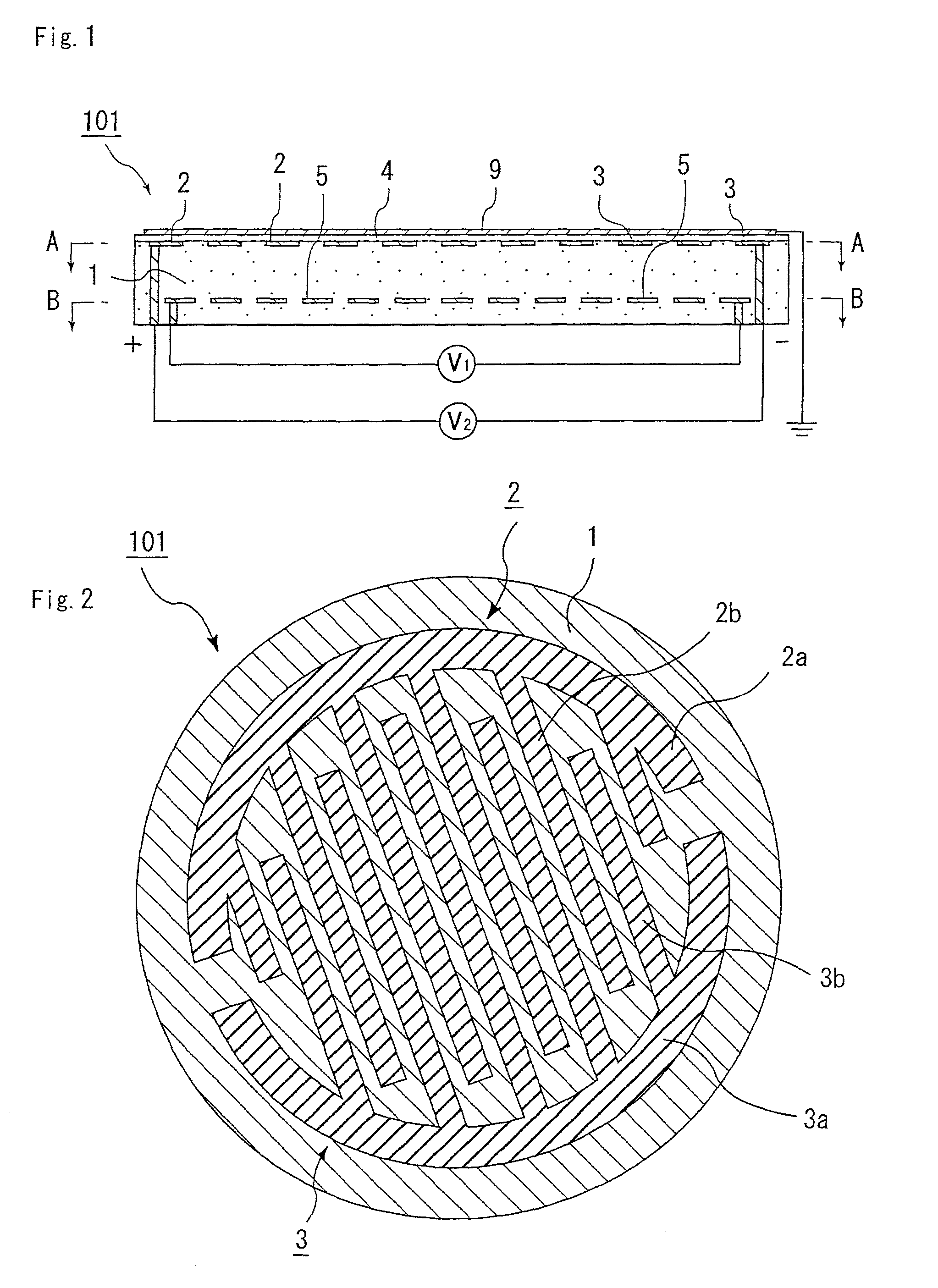Ceramic substrate for semiconductor production and inspection devices
a ceramic substrate and inspection device technology, applied in the field of ceramic substrates, can solve the problems of deterioration of temperature-rising properties or heat uniformity of ceramic substrates, and achieve the effects of improving heat uniformity, lowering heat conduction barriers, and improving sinterability
- Summary
- Abstract
- Description
- Claims
- Application Information
AI Technical Summary
Benefits of technology
Problems solved by technology
Method used
Image
Examples
examples 1 to 3
Hot Plate (Reference to FIG. 9)
[0133](1) An aluminum nitride sintered body was obtained by: mixing 100 parts by weight of aluminum nitride powder (manufactured by Tokuyama Corp., average particle diameter 1.1 μm) which is fired in the air at 500° C. for one hour, 4 parts by weight of yttrium oxide (Y2O3: yttria, average particle diameter 0.4 μm) and 11.5 parts by weight of acrylic resin binder; putting the mixture into a hexagonal columnar mold; and then hot pressing it in a nitrogen atmosphere under the conditions: at a temperature of 1890° C. and a pressure of 150 kg / cm2 for three hours. Ceramic substrates having, respectively, a diameter of 280 mm and a thickness of 19 mm (Example 1), a diameter of 310 mm and a thickness of 5 mm (Example 2) and a diameter of 350 mm and a thickness of 3 mm (Example 3) were obtained by processing the above aluminum nitride sintered body into disk shapes and varying a surface grinding amount.
(2) A conductor containing paste was printed on the bottom...
examples 4 to 6
[0140](1) Green sheets 50, which were 0.47 mm in thickness, were obtained: by using a paste containing alumina:93% by weight, SiO2:5% by weight, CaO:0.5% by weight, MgO:0.5% by weight, TiO2:0.5% by weight, an acrylic binder:11.5 parts by weight, a dispersant: 0.5 part by weight and 53 parts by weight of alcohol comprising 1-butanol and ethanol; and forming it by a doctor blade method.
(2) Subsequently, after drying these green sheets at 80° C. for 5 hours, to the green sheets having a necessity of being processed, portions which will become through holes, in which lifter pins for a semiconductor wafer, 1.8 mm, 3.0 mm and 5.0 mm in diameter, respectively, and portions which will become conductor-filled through holes for being connected with external terminals were formed by punching.
(3) Conductor containing paste B was prepared by mixing 100 parts by weight of tungsten particle having an average particle diameter of 3 μm, 1.9 parts by weight of an acrylic binder, 3.7 ...
examples 7 to 9
Manufacture of Electrostatic Chucks Made of AlN with Heaters (FIGS. 1 to 3)
[0149](1) Next, green sheets 50, which were 0.47 mm in thickness, were obtained by: using a paste prepared by mixing 100 parts by weight of aluminum nitride powder (manufactured by Tokuyama Corp., average particle diameter 1.1 μm) fired in the air at 500° C. for one hour, 1,2, 4 parts by weight of yttria (average particle diameter 0.4 μm), 11.5 parts by weight of acrylic binder, 0.5 part by weight of a dispersant and 53 parts by weight of alcohol comprising 1-butanol and ethanol; and forming it by a doctor blade method.
(2) Subsequently, after drying these green sheets 50 at 80° C. for 5 hours, to the green sheets having a necessity of being processed, portions which will become through holes, in which lifter pins for a semiconductor, 1.8 mm, 3.0 mm and 5.0 mm in diameter, respectively, and portions which will become conductor-filled through holes for being connected with external terminals were formed by punc...
PUM
| Property | Measurement | Unit |
|---|---|---|
| thickness | aaaaa | aaaaa |
| thickness | aaaaa | aaaaa |
| temperature | aaaaa | aaaaa |
Abstract
Description
Claims
Application Information
 Login to View More
Login to View More - R&D
- Intellectual Property
- Life Sciences
- Materials
- Tech Scout
- Unparalleled Data Quality
- Higher Quality Content
- 60% Fewer Hallucinations
Browse by: Latest US Patents, China's latest patents, Technical Efficacy Thesaurus, Application Domain, Technology Topic, Popular Technical Reports.
© 2025 PatSnap. All rights reserved.Legal|Privacy policy|Modern Slavery Act Transparency Statement|Sitemap|About US| Contact US: help@patsnap.com



